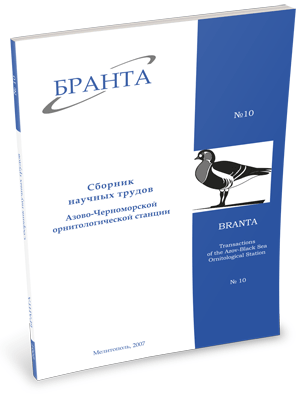
Transactions
of the Azov-Black Sea Ornithological Station



Use of feeding macrozoobenthos of Molochny Liman by waders during migration
Kirikova T.A., Antonovsky A.G.
This work for the first time gives the estimation of feeding resources of Molochny Liman for waders and analyses use of feeding macrozoobenthos by waders in various shallows.
The publication is based on authors’ materials on studies of macrozoobenthos of coastal shallows along the all liman coast (1997-2002) and on special studies of feeding base of waders on the sand spit at the village Stepanovka (1996-2001).
We analyzed 47 counts of waders, carried out by the Azov-Black Sea Ornithological Station. One of the authors took part in 36% of these counts.
From 1996 to 2002 in coastal shallows of Molochny Liman, which are feeding areas of waders, 46 species of macrozoobenthos were recorded, 18 of them are feeding objects of waders.
There were estimated biomass and energetic value of feeding macrozoobenthos, its reserves (tons) in raw material and in energetic equivalent (gigajoules) in coastal liman shallows. It is find out that in different seasons migratory waders generally have enough volume of food reserves.
The key role of shallows of the sand spit was proved as a roosting place and foraging area for waders during their migratory stopovers at Molochny Liman.
Numbers of most species of waders during spring migration correlate with biomass of one of the taxonomic group of macrozoobenthos, while during autumn migration it correlates with biomass of several taxonomic groups. It is suggested that feeding selectivity in spring and its absence in autumn allows waders to gain fat reserves in necessary volume during their migratory stopover and moult.
Read the paper in a PDF file